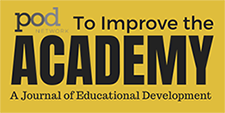Professional and Organizational Development Network in Higher Education

To Improve the Academy: A Journal of Educational Development
Date of this Version
Winter 2021
Document Type
Article
Citation
To Improve the Academy: A Journal of Educational Development (winter 2021) 40(2): 234-268
doi: 10.3998/tia.137
Abstract
Institutions are redesigning gateway courses—lower-division courses known to create student success bottlenecks—to influence persistence and completion goals. These initiatives, student success course redesigns (SSCR), are specialized versions of course design institutes (CDIs). This investigation into SSCRs uses content analysis to examine the implementation plans created during a SSCR. Results demonstrated that the majority of the strategies planned focused on the Learning key performance indicator (KPI), and the minority of the planned-for strategies focused on the Monitoring Student Performance KPI. A more granular analysis of the Learning strategies revealed five themes: Content, Assessment, Pedagogy, Syllabus, and Student Success. Additional results indicated the majority of planned strategies would occur out of class, and disciplinary differences between science, technology, engineering, and mathematics (STEM) and non-STEM faculty for pedagogical and content design changes. Results also demonstrated a need for more faculty to utilize actionable language for course redesign strategies. Moreover, the implementation plans provided useful assessment feedback of the CDI itself.
Included in
Curriculum and Instruction Commons, Higher Education Commons, Higher Education Administration Commons, Higher Education and Teaching Commons, Other Education Commons


Comments
License: CC BY-NC-ND